http://www.ftech.net/~regia/games.htm
Games of the Viking & Anglo-Saxon Age

Fig. 1: Replicas of various Viking Age games and toys. (Click on image for a closer look)
Dice Games
Dice were made of antler for the most part, although examples of bone, walrus ivory and jet are also known. More perishable materials, such as wood and horn, were also likely to have been used. They were often rectangular, with the 1 and 2 on either end and the 3,4,5, and 6 on the four long sides.Others types were also found including modern shaped and numbered examples. Although the numbers on opposite faces do not always add up to seven (as on a modern dice), this arrangement is the most common. One curious dice found in Viking Dublin is a cubic dice, much like most modern dice, but has the curious number combination of 3, 4, 4,5, 5, 6. This is reminiscent of the 'average' dice used in some modern 'wargaming' (in this case with the numbers 2, 3, 3, 4, 4, 5). The nature of the games played with dice are unknown, but simple games such as 'who can get the highest (or lowest) number were probably common (and are suggested by some of the sagas), as were games similar to 'liar dice' or 'yahtzee'. The 'long-dice' are usually found in sets of two or three, and normally have the numbers 1 and 2 on the smallest face, suggesting they were used for a game where low numbers were needed, although there is also a suggestion they were used for tabula/kvatrutafl. The use of the 'average' dice is unknown, but again may be for tabula/kvatrutafl.
Board Games
There are many finds of board games and gaming pieces from Scandinavia and from the British Isles. Gaming pieces were often hemispherical and made of virtually anything. The most common were made out of stones, glass beads, bones, amber, clay or even horses' teeth. The 'ball' of a ball and socket joint makes an ideal playing piece. To distinguish between the sides, bones can be dyed, stones may be of different natural materials, or glass beads may simply be of different colours. Finds of several light and several dark pieces together have been made sometimes with a single piece being a different shape, like a sea urchin, in the same area.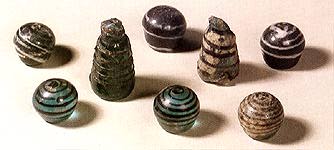
Another type of gaming piece found have been made from disk shaped slices of hart's pedicle which must have been taken from a fully grown male deer carcass since this would not have been available with fallen antler. In some cases these have been beautifully carved and decorated and often have a hole in the centre where the porous heart of the pedicle has been removed.Fig. 2: Coloured glass gaming pieces from the Viking town of Birka in Sweden. (Click on image for a closer look)
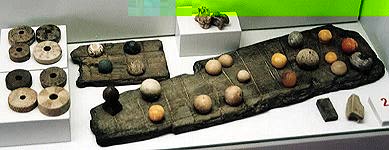
Writings of the times mention various board games but it can be quite difficult to work out exactly how the game was played. The word tafl (literally 'table') was used to describe a board game, with the pieces being referred to as toflur or hunn. Among the many names for games known from literature we have brannantafl, halatafl, hnefatafl, hnottafl, hr??tafl (literally 'quick-tafl'), kvatrutafl, merels, skaktafl and tabula, although the rules for many of these remain unclear. In any case the rules may have differed from place to place.Fig. 3: Gaming pieces from the Viking town of Hedeby in Denmark. Those on the left are made from deer pedicles, the others are of bone, stone and other materials. (Click on image for a closer look)
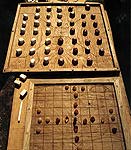
Fig. 4: Reproduction Viking gaming boards. Top: Halatafl board with playing pieces made from horses teeth. Bottom: Hnefatafl board with amber playing pieces. (Click on image for a closer look)
Hnefatafl
This was probably the commonest of the board games played, and was almost certainly a Germanic development of the Roman game latrunculi (soldiers). Hnefatafl is a basic form of tactical combat, where a bodyguard of men are protecting their lord from a larger hostile force. Indeed it is possible for a parallel to be drawn between the tafl games and certain mythological situations. It has been stated that 'along with Runes, dice were given to mankind by the All-Father, Odin, and the world has his tafl-board'.The game can be played on a board with 7x7, 9x9, 11x11, 13x13, 15x15 or a 19x19 squares. The centre often has special markings.
A beautiful carved board with 13x13 squares was found at Gokstad in Norway. This is a double sided board with a nine men's morris layout carved on the reverse side as with other less impressive examples. Many other wooden tafl boards have also been found throughout the Viking and Anglo-Saxon world, but some of the boards were much simpler affairs being only marked out with charcoal or scratched onto the surface of slices of rock.
The pieces for these games were usually hemispherical. For boards with 9 squares a side, 16 light and eight dark pieces were used, with an additional king. Boards with more squares used 24 light, 12 dark and a king (hnefi or cyningstan).
Although by the later Middle Ages chess had taken over, hnefatafl still survived in Wales and is described in a manuscript of 1587. It was then called tawlbwrdd and was played on an 11x11 board with 24 light pieces, 12 dark pieces and a king.
In 1732 a Swede called Linnaeus discovered a game called tablut whilst he was travelling in Lappland. The Lapps called the pieces "Swedes" and "Muscovites" and played the game on a 9x9 board.
The Rules
The 'king' moves first. He has half the number of pieces
his opponent has (6/12 in the 7x7 version, 8/16 in the 9x9 version, 12/24
in the 11x11 and 13x13 version, 24/48 in the 19x19 version). He wins the
game if he can manage to get his 'king' out into one of the corner squares
(the large 19x19 version often allows the king to win if he can reach the
edge of the board). His opponent can win by trapping the king.
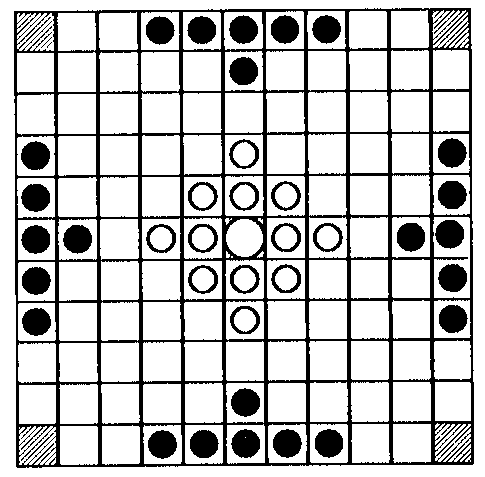
All pieces including the king move like castles in chess. That is they may move any number of squares horizontally or vertically. No piece is allowed to jump another, be it an opposing piece or one of the moving player's pieces. Diagonal moves are not allowed. Only the king may land on the centre or corner squares. Other pieces may cross the centre square but not stop on it.

Ordinary pieces are captured when they are surrounded on two opposite sides by the opposing player as shown in Figure 6. When the piece is taken it is removed from the board. It is possible to capture more than one piece in the same move. Figure 7 shows illegal captures.
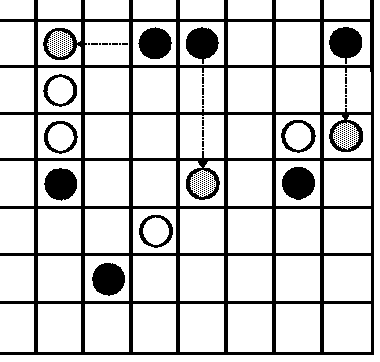
The centre and corner squares are counted as an opposing piece whenever a piece is beside it. A piece beside these squares can be captured when an opposing piece moves opposite the special square with the piece in between (Figure 8.).
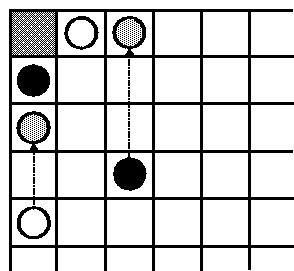
If a piece is moved so that it stops in between two opposing pieces, it is not taken. This is known as a 'resting move'(Figure 9.). One of the opposing pieces may be moved away and back again (taking two turns) to take the resting piece. Of course when the player moves one of his pieces, the resting piece will probably be moved.

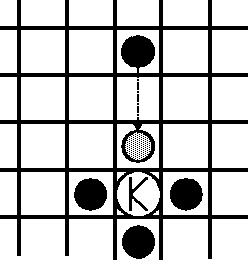
Taking the king is more difficult than taking any of the other pieces. The king must be surrounded on all four sides (Figure 10.). If he is surrounded only three sides with the forth side being the board edge (Figure 11.) the king is not captured. If the king is the only piece which can move and he is blocked off from any other square, the game is drawn. If the king is surrounded on three sides with the centre square being the fourth, (Figure 12) the king is captured and the attacking player wins.
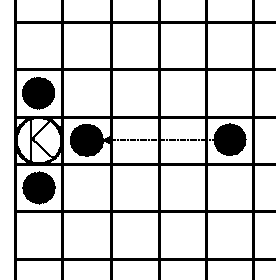
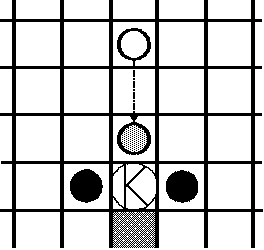
VARIATIONS: As mentioned before, the method of play described is only an educated guess (based on an Icelandic version of 1732). Feel free to experiment with the 'rules'. One of the most common variations is to change the size of the playing board. Boards of varying sizes have been found ranging from 7 x 7 squares to 19 x 19 squares. A point worth noting is that the size of the board dictates the length of gameplay. The larger the board the longer the game.
As well as various board sizes, some other modifications to the game can easily be made. A simple variation is to allow the king to exit anywhere along the edge of a board. If this rule is played then the king's player must announce that he can get to an edge before the attacker's move. If he can get to two edges at the same time he has won. It is also possible that dice were used when playing tafl.
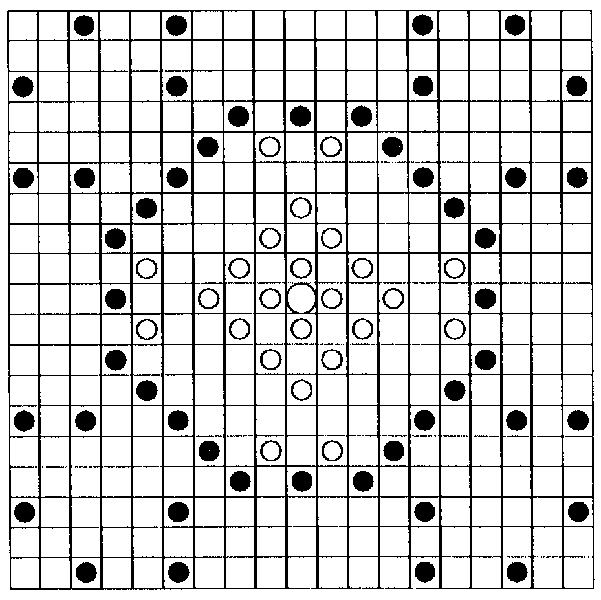
Duodecim scripta (or Tabula or Kvatrutafl)
This game is a development of the popular Roman game of duodecim scripta, also known as tabula or alea, which was also played in Germany and Scandinavia in the Roman Iron Age, where it appears to have been known as katrutafl. Several wooden boards for this type of game are known from the Saxons' Germanic homeland, and metal fittings for boards of this type have been found from the Viking Age in Germany and Denmark. The only known surviving British example of a tabula board was found in Gloucester; dating to the eleventh century. The decorated bone plates that once covered the now rotted wooden board and the playing pieces, beautifully carved from bone and antler, can be seen in the Gloucester city museum. Playing pieces suitable for this game are a more common find.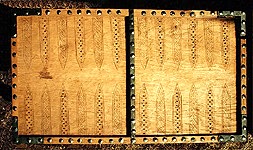
RulesFig. 14: Reconstruction of a Viking Age Tabula board based on excavated examples (Click on image for a closer look)..
The actual rules used at the time are not known but it may have been played like this:
15 white and 15 black (or red) pieces are used and three dice.
All pieces start off the board. Each player throws one die. The player with the highest score goes first.
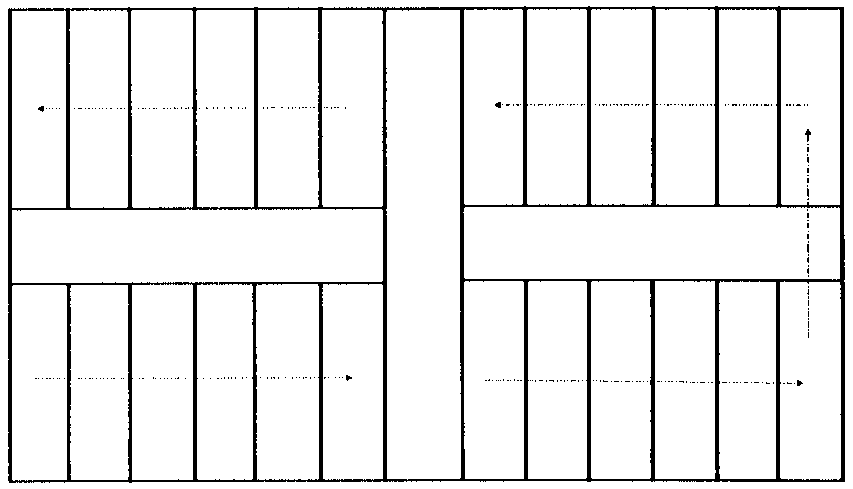
The players alternately throw the three dice then move, or attempt to move, one or more pieces according to the following rules:
Each dice must be treated separately, i.e. pieces do not move according to their combined score, but according to their individual values. They are moved according to the number shown on the dice, each dice indicating a single turn. For instance if you throw a 5, a 4 and a 3 you can
- move one piece 5+4+3 steps forwardHowever, when the dice scores are combined you must be able to make each move separately, if you start to and find that you cannot because you are blocked by the other player's pieces the move is annulled and you loose that turn.
- move one piece 5+4 and another 3 forward
- move three pieces one by 5 one by 4 and one by 3.
A piece may only stop on a gate that is a.) free of any other piece or b.) occupied by one or more of your own pieces or c.) occupied by a single one of the opponent's pieces. You may not move onto a 'gate' occupied by more than one of your opponent's pieces. In the event that you stop on a gate occupied by a single one of your opponent's pieces, you capture that piece (Figure 15) and place it on the central 'bar'. Your opponent must then bring that piece back into play before they move any other piece.
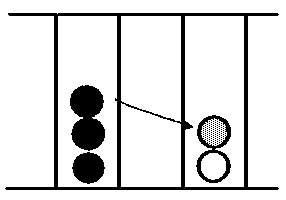
It is quite possible that the position of your opponent's pieces on the board may limit your choice of moves, or may even prevent you from moving at all. If you are able to move you must do so, even if the move is not one you would choose to make.
Bringing pieces into play.
A piece must be brought into play on one of the first six gates, corresponding to the value on one dice. The same rules of capture apply as in a normal move.
Once a piece is on the board, it is moved in an anticlockwise direction towards the 'exit gate'. Both players move in the same direction around the board. There is no limit to the number of pieces a player may place on one gate.
Throwing a double.
If you throw a double, you may play the number shown on each dice twice, or as many times as possible up to a total of four.
Bearing off pieces
Once you have managed to bring all 15 pieces into play you may start to 'bear off' pieces. This is done by throwing a high enough number to take you beyond the exit gate. Once a piece is 'born off', it is out of play.
The Winner
The winner is the first person to bear off all fifteen pieces.
Merels or Nine Men's Morris
From the earliest times (it was played even in ancient Egypt!) this game has been known as 'the game on the other side of the board'. Several boards found in both Viking and Anglo-Saxon contexts have had hnefatafl on one side and nine men's morris on the other. However the game has also been found rather unexpected places - ship's timbers, loose boards, benches, lumps of rock and, later, even on church pews and tiles.
We do not know which of the 'tafl' names was used for this game, but the latin word merels is often used for this game just after Anglo-Saxon times. The name merels comes from the low latin word merrelus, meaning a 'token, counter or coin'.
Nine men's morris is a simple game. The board is quickly made, and pieces could be any set of black (or red) and white stones, bones, etc., which could also be used for any other game.
The game remains well known even today but we do not know the rules of the Viking or Anglo-Saxon version. It is indicated that a die may have been used. Perhaps only particular scores, for example - even numbers, gave the right to move. However the way it is played today is as follows:
Rules
The nine mens morris board is made up of three concentric
squares connected by intersecting lines in the centre of each of the square's
sides. Players start with nine pieces off the board. Each player takes
it in turn to place one of his pieces on one of the intersections. If a
player forms a line of three, one of the opposing pieces is removed from
play by taking it off the board. Wherever possible the piece taken should
not be taken from an existing line of three.
When all pieces have been placed on the board, the players move the pieces around one intersection at a time. On completion of a line of three an opposing piece is taken as before. Forming a line of three is called forming a 'mill'. There is nothing to stop a player forming a mill, moving a piece away and then moving it back again in subsequent moves. The winner of the game is the player who removes all the opponent's pieces.
A simpler version of nine mens morris is the game of 'three mens morris' familiar to most people today, albeit in a modified form, as 'noughts and crosses.' It is played in the same way as nine mens morris, except the board is made up of three lines of three positions (or on the intersections of a 2x2 section of a larger squared board). The winner is the first person to form a mill. Pieces may not move diagonally, or jump over other pieces. This may be the game known as hr??tafl ('quick-tafl').
Halatafl
At Ballinderry in Ireland a little game board has been found with holes in place of squares and with the centre and corner positions clearly marked. Two notches on the board indicate a division between white and red pieces similar to modern solitaire. It is thought to be the halatafl known from the sagas. An alternative idea is that this could be used for a form of the game known as fox and geese or a 7x7 hnefatafl board or, indeed, all three.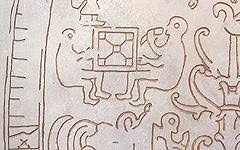
The Ockelbo stone from Sweden shows a board with the same markings at the centre and the corners and with four oblique lines. The special markings at the centre and corners may suggest that these squares were clear at the beginning of the game.Fig. 18: Two men playing halatafl? The Ockelbo Stone, Sweden. (Click on image for a closer look)
Rules
A set of rules for halatafl is as follows:-
The initial set up as on figure 19 - white and red have 22 identical 'men' set up on the board with 49 holes marked. The centre and corner holes are left empty.

The pieces can be moved in two different ways; either they move one step at a time either forwards, sideways or diagonally along the marked lines, but never backward. Or they jump over a neighbouring piece to an empty hole behind it. They may proceed jumping as many times as possible in any direction or even backwards. The jump can be made over any piece - your own or your opponent's - and if you jump over one or more of your opponent's pieces they are taken and removed from the board.Fig. 19: The initial setup for halatafl. (Click on image for a closer look)
White opens the game by moving a piece onto the centre hole; red takes it by jumping over it and the game proceeds until one of the players has fewer than five pieces left - and loses.
A jumping piece may make an intermediary landing at a corner hole. However no piece is allowed to stay there.
Chess and Draughts
Contrary to what many books say, neither chess or draughts were commonly played in the early medieval period. Chess did not become popular until brought back by Crusaders after the first Crusade (1096-99) and draughts was not played until much later in the Medieval period. The Lewis chessmen, although Viking, date to the mid twelfth century. However, recent excavations at Dublin and York have revealed playing pieces shaped like Arabic chess pieces, but with pre-Conquest style Scandinavian style decoration. It would not be strange if the Vikings, thanks to their contacts with the Arab world, learnt this game earlier than other Europeans, although this is just speculation. Chess certainly did not become popular or widespread until the twelfth century.Knucklebones and Fivestones
A form of 'knucklebones' or 'fivestones' was played, probably the form where a number of small bones (usually pig or sheep knuckles) or stones are taken in the palm of the hand. The bones are then flicked in the air and the idea is to catch as many bones as possible on the back of the same hand. The winner is the player who catches most bones. Other versions of this game might include the version where one stone is taken in the palm of the hand whilst the others are left on the ground. The stone/bone on the hand is thrown into the air. Whilst it is in the air the player must pick up the stones/bones on the ground with the same hand and catch the thrown piece before it hits the ground. If the player succeeds with one piece in his hand, he moves onto two, then three, etc.. Another popular form of knucklebones would have been the game we now call 'pass the pig', although particular bones from a sheep's foot would have been used as playing pieces. This would have been a popular game to gamble on.Some Viking Age sites have yielded sets of knuckles and small leather balls. It has been suggested that these were used to play a simple form of skittles. There is also an eleventh century reference to monks playing some sort of skittles like game in monastery cloisters.
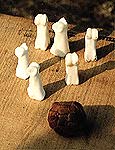
Fig. 20: Game of 'skittles' made using sheep knucles and a small leather ball. (Click on image for a closer look).
Riddling
One of the most popular games was riddling. A warrior was not considered to be up to much unless his word skill was as good as his weapon skills. Riddling was a good way of demonstrating this skill and many of the riddles of the time are full of double meanings which suggest two answers, one innocent, the other more 'raunchy'. These riddles could be anything from a one to a hundred lines long and sought to describe everyday objects in an unusal way. Part of the skill of riddling was to be able to construct the riddle using the correct 'poetic' conventions. Obviously, as well as the correct construction, it was important to make sure that the description given was not too obscure. Here are some actual Saxon riddles (Answers at end).I'm by nature solitary, scarred by spearANSWERS:-
and wounded by sword, weary of battle.
I frequently see the face of war, and fight
hateful enemies; yet I hold no hope
of help being brought to me in the battle,
before I'm eventually done to death.
In the stronghold of the city sharp-edged swords,
skillfully forged in the flame by smiths
bite deeply into me. I can but await
a more fearsome encounter; it is not for me
to discover in the city any of those doctors
who heal grievous wounds with roots and herbs.
The scars from sword wounds gape wider and wider
death blows are dealt me by day and by night.Wob's my name if you work it out;
I'm a fair creature fashioned for battle
When I bend and shoot my deadly shaft
from my stomach, I desire only to send
that poison as far away as possible.
When my lord, who devised this torment for me,
releases my limbs, I become longer
and, bent upon slaughter, spit out
that deadly poison I swallowed before.
No man's parted easily from the object
I describe; if he's struck by what flies
from my stomach, he pays for its poison
with his strength - speedy attonement for his life
I'll serve no master when unstrung, only when
I'm cunningly nocked. Now guess my name.Favoured by men, I am found far and wide,
taken from woods and the heights of the town,
From high and from low. during each day
bees brought me through the bright sky
skillfully home to a shelter. Soon after that
I was taken by men and bathed in a tub.
Now I blind them and chasten them, and cast
a young man at once to the ground,
and sometimes an old one too.
He who struggles against my strength,
he who dares grapple with me, discovers immediately
that he will hit the hard floor with his back
if he persists with such stupidity.
Deprived of his strength and strangely loquacious,
he's a fool, who rules neither his mind
nor his hands nor his feet.
Now ask me, my friends,
who knocks young men stupid,
and as his slave binds them
in broad waking daylight?
Yes ask me my name.The dank earth, wonderously cold,
first delivered me from her womb.
I know in my mind I wasn't made
from wool, skillfully fashioned with skeins.
Neither warp nor weft wind about me,
no thread thrums for me in the thrashing loom,
nor does a shuttle rattle for me,
nor does the weaver's rod bang and beat me.
Silkworms didn't spin with their strange craft for me,
those strange creatures that embroider cloth of gold.
Yet men will affirm all over this earth
that I am an excellent garment.
O wise man, weigh your words
well, and say what this object is.A strange thing hangs by man's hip,
hidden by a garment. It has a hole
in its head. It is stiff and strong
and its firm bearing reaps a reward.
When the retainer hitches his clothing
high above his knee, he wants the head
of that hanging thing to find the old hole
that it, outstretched, has often filled before.I'm told a certain object grows
in the corner, rises and expands, throws up
a crust. A proud wife carried off
that boneless wonder, the daughter of a king
covered that swollen thing with a cloth.On the way a miracle: water become bone.
On earth there's a warrior of curious origin.
He's created, gleaming, by two dumb creatures
for the benefit of men. Foe bears him against foe
to inflict harm. Women often fetter him,
strong as he is. If maidens and men
care for him with due consideration
and feed him frequently, he'll faithfully obey them
and serve them well. Men succour him for the warmth
he offers in return; but this warrior will savage
anyone who permits him to become too proud.A woman, young and lovely, often locked me
in a chest; she took me out at times,
lifted me with fair hands and gave me
to her loyal lord, fulfilling his desire.
Then he stuck his head well inside me,
pushed it upwards into the smallest part.
It was my fate, adorned as I was, to be filled
with something rough if that person who possessed me
was virile enough. Now guess what I mean.I saw a creature: his stomach stuck out behind him,
enormously swollen. A stalwart servant
waited upon him. What filled his stomach
had travelled from afar, and flew through his eye.
He does not always die in giving life
to others, but new strength revives
in the pit of his stomach: he breathes again.
He fathers a son; he's his own father also.
1. Shield; 2. Bow; 3. Mead; 4. Mailshirt; 5. Key; 6. Dough/bread; 7. Ice; 8. Fire; 9. Helmet; 10. Bellows.
Ben Levick and Mark Beadle January 1992
![]() Click
here to return to Drengham
Click
here to return to Drengham
Last updated 10th January 1997